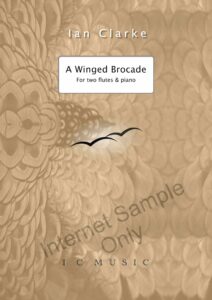A Winged Brocade

A Winged Brocade – (2 flutes & piano) [intermediate/advanced – C ft closed-holes]
A Winged Brocade is a new lyrical piece for two flutes and piano playable on closed or open-hole flutes – suitable for C or B foot. Intermediate/advanced.
The title gives a hint of the imaginative musical world of the piece. A ‘brocade’ is a richly decorative woven fabric often with gold and silver threads, which the title combines with the image of being ‘on the wing’. With interwoven parts and floating melodies, the piece gives an opportunity to explore gesture, texture, and nuance. There are occasional simple harmonic substitutions alternating with conventional fingerings.
“I was lucky enough to premiere A Winged Brocade with the marvellous Paul Edmund-Davies and Scott Mitchel at the Scottish Flute Course back in 20?? and have gone on to perform it with some wonderful colleagues in Europe and the USA. At last here it is in print.” – Ian Clarke Nov 2023.
Pan – Journal of the British Flute Society
This review first appeared in Pan, the journal of the British Flute Society and is reproduced with permission. Join the BFS: membership starts from £25 a year.
This is a new trio for two flutes and piano by one of the UK’s favourite flute player/composers, Ian Clarke. Lyrical in style, the piece can be played on closed hole flutes with C foot; aside from some harmonics and very occasional alternative fingerings, there are no extended techniques required here. The parts are evenly distributed and use the full range of the flute, with flute 1 often inhabiting the top register with soaring melodic lines. There’s plenty of opportunity for cantabile playing here.
The piece was premiered by Ian Clarke, Paul Edmund-Davies and Scott Mitchell at the Scottish International Flute Summer School, and it has since been performed in Europe and USA. The ‘brocade’ of the title refers to a ‘richly decorative woven fabric often with gold and silver threads’ – as such, the two flutes weave lines around each other in an expressive dialogue. A good sense of ensemble is required, with each player needing rhythmic precision within the almost meditative character of the music. The piano provides a calm and relatively simple accompaniment, with a gentle bass line over which the right hand enters into a supportive conversation with the flutes.
This is likely to be a popular piece, especially amongst intermediate or advanced players who enjoy expressivity and harmonic simplicity within a gentle and lyrical soundworld. It’s also a great place to develop great control of intonation across the range of the instrument.
The edition is well presented with practical page turns. A must for all Ian Clarke fans!
Carla Rees